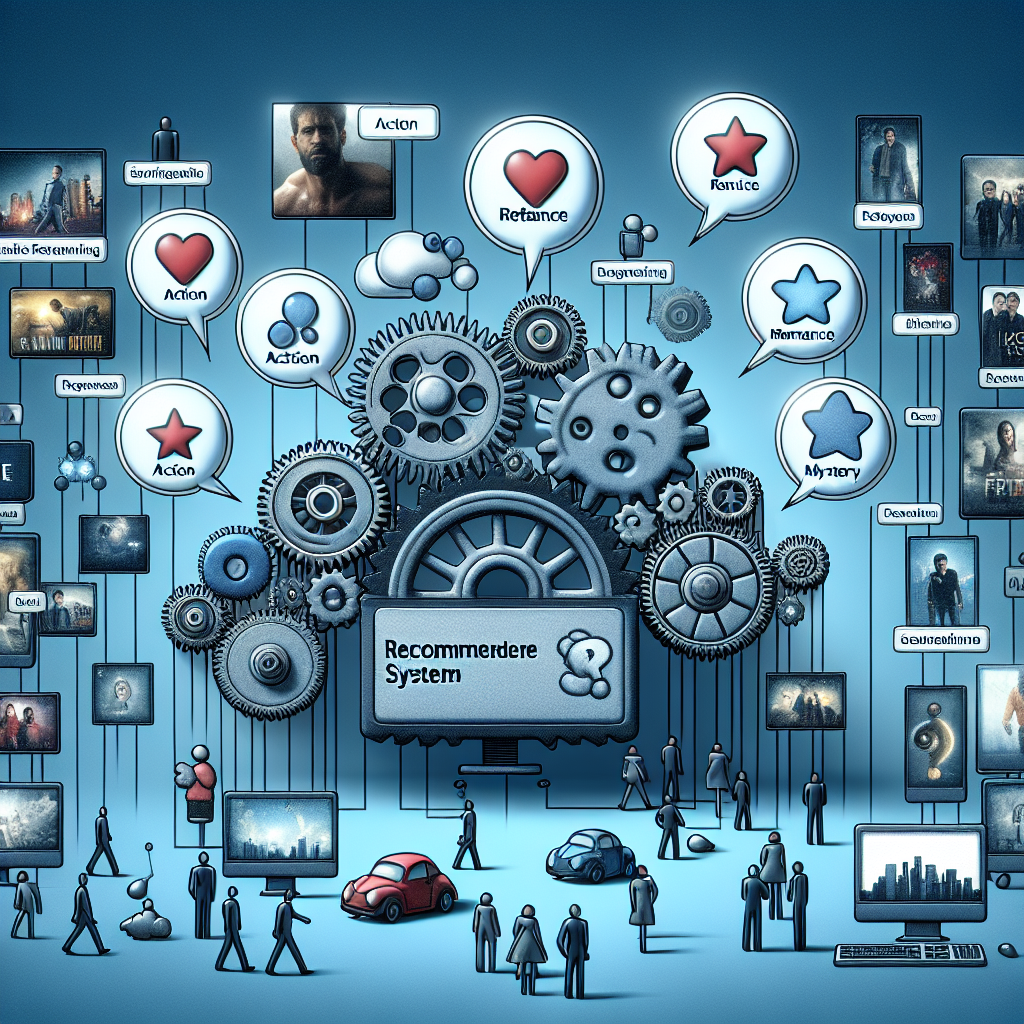Discover how recommender systems work and how Netflix uses them to recommend what to watch. Explore the power of personalized recommendations.

Recommender systems have become an essential component of contemporary digital platforms, significantly affecting how users interact with content across various industries. These systems utilize algorithms to analyze user preferences, behaviors, and collected data to offer personalized recommendations.
This personalization is especially prominent in entertainment platforms, such as Netflix, which boasts a vast library of films and series. The ability of recommender systems to predict what individuals will be interested in watching is not only vital for enhancing user engagement but also integral for driving content consumption.
The importance of recommender systems manifests in their capability to simplify the content discovery process. Given the sheer volume of available media, users often find it challenging to sift through countless options. By employing advanced data analytics and machine learning techniques, recommender systems can present tailored suggestions, thus streamlining the experience. This personalization fosters user retention and satisfaction, as individuals are more likely to engage with content that aligns with their tastes.
Netflix’s recommendation engine has undergone significant transformations since its inception, reflective of the rapid evolution of technology and data analytics. Initially, when Netflix was launched in 1997, its recommendation system relied on a basic algorithm using user ratings captured from their extensive library of movies. This simple collaborative filtering method matched users with similar tastes and suggested content based on collective preferences. By analyzing viewership patterns, the engine could propose titles that users with similar viewing habits enjoyed.
As Netflix expanded its audience and the amount of data collected grew exponentially, the need for a more sophisticated approach became apparent. In 2006, Netflix held its famous $1 million competition, aiming to improve its recommendation efficacy. This contest culminated in innovative algorithm development, showcasing advances that blended collaborative filtering with additional variables like genre and actor relations. Researchers and developers worldwide contributed to refining these algorithms, enhancing personalization capabilities for every user.
With the advent of machine learning in the early 2010s, Netflix took a significant leap forward. The integration of advanced statistical techniques into the recommendation system enabled a more nuanced understanding of viewer preferences. By utilizing deep learning algorithms, Netflix began to analyze not just user ratings, but also behaviors such as viewing times and pause events. This approach allowed the system to evolve from merely suggesting based on past behavior to predicting future preferences more accurately.
The contemporary recommendation engine employs a diverse array of data inputs, such as watch history, user interactions, and demographic information. This intricate algorithm now predicts content suggestions with remarkable precision, enabling Netflix to deliver highly personalized experiences. The trajectory of Netflix’s recommendation system illustrates not only the power of technology in enhancing user engagement but also the critical role that data plays in tailoring content in the evolving digital landscape.

Recommender systems, such as those used by Netflix, rely heavily on user preferences to curate individualized content suggestions. By analyzing various user interactions, Netflix gains insights into what users enjoy, thus shaping a more personalized viewing experience. Key metrics for assessing user preferences include ratings, watch history, and browsing habits.
Ratings are often one of the most straightforward ways to gauge a viewer’s reaction to a particular title. When users rate shows and movies, they provide explicit feedback, which the system uses to identify trends and preferences. For instance, if a user consistently rates action films highly, Netflix can deduce a strong inclination towards that genre and recommend similar titles. This not only assists in presenting relevant choices but also encourages deeper engagement with the platform.
In addition to explicit ratings, Netflix pays close attention to watch history. Every time a user watches a show or movie, that interaction is recorded and analyzed. This data encompasses various factors, including the duration of viewing sessions, time spent on specific titles, and even repeated viewings. Such information contributes to understanding user preferences on a deeper level, allowing Netflix to refine its suggestions. Depending on a user’s consumption patterns, the system may identify particular themes or actors the user favors, leading to more tailored recommendations.
Browsing habits also play a significant role in analyzing user preferences. The categories and genres users explore, the searches they perform, and the content they click on contribute valuable insights into their tastes. By observing this behavior, Netflix can adjust its algorithms to accommodate evolving interests and present a diverse yet relevant selection of titles.
Overall, by merging data from ratings, watch history, and browsing habits, Netflix intelligently crafts a unique experience for each user. This dedication to understanding individual preferences remains a cornerstone of Netflix’s success in the competitive streaming landscape.
Data science is integral to the functionality of recommender systems, serving as the backbone for analyzing user behavior and preferences. These systems, including those utilized by streaming platforms like Netflix, rely heavily on large datasets comprising user interactions, viewing histories, and demographic information. Data science methodologies leverage this information to enhance the accuracy and relevance of recommendations.
One prominent technique employed in the realm of data science is collaborative filtering. This approach analyzes patterns and similarities among users and items, creating recommendations based on collective preferences. For instance, if User A and User B share similar viewing habits, the system may suggest to User A films that User B enjoyed but User A has not yet watched. This method utilizes user-generated data effectively, illuminating the nuanced tastes of individuals and groups.
Another critical technique is content-based filtering, which examines the attributes of items—such as genre, director, and actors—to recommend similar content to users. By analyzing a user’s past preferences, data science identifies characteristics common among their favored shows and films, allowing the recommender system to present options aligned with these traits. This dual approach, blending collaborative and content-based filtering, ensures that recommendations cater to both individual tastes and collective trends.
Further, advanced algorithms, including machine learning models, play a pivotal role in refining recommendations. By continuously learning from new data inputs, these models evolve, adjusting recommendations to reflect changing user preferences. Techniques such as matrix factorization and deep learning have emerged, enabling a more sophisticated understanding of complex relationships within the data, thus enhancing the system’s predictive capabilities.
Incorporating data science methodologies significantly augments the quality of recommendations, tailoring the user experience while maximizing engagement. As data continues to grow in volume and complexity, the role of data science in developing effective recommender systems will remain vital, fostering an increasingly personalized and enjoyable viewing experience.
Understanding the algorithms that drive Netflix’s recommendation system is crucial to grasping how the platform personalizes content for its users. Primarily, Netflix employs three main types of algorithms: collaborative filtering, content-based filtering, and hybrid models, each with its unique approach to delivering tailored recommendations.
Collaborative filtering is a statistical technique that assesses user behaviors and preferences. This method operates on the premise that if two users share similar tastes in one set of items, they are likely to enjoy similar content in another set. For example, if user A and user B have watched and rated several films in common, a film that user A enjoyed, which user B has not yet seen, may be recommended to user B. Collaborative filtering can be further divided into user-based and item-based approaches, allowing the system to draw from a rich pool of user interactions.
Content-based filtering, on the other hand, analyzes the attributes of items that a user has previously watched and enjoyed. For instance, if a viewer consistently watches romantic comedies featuring particular actors or directors, the algorithm will recommend other films that share similar characteristics. This method empowers Netflix to cater to specific user preferences, enhancing the viewing experience through familiarity.
Lastly, hybrid models combine the strengths of both collaborative and content-based filtering. By leveraging multiple sources of information, these algorithms can deliver more accurate and diverse recommendations. Netflix’s implementation of hybrid approaches allows it to reduce the limitations encountered by each method individually, such as the cold-start problem in collaborative filtering, where new users lack sufficient data. The fusion of these algorithms exemplifies Netflix’s commitment to refining its recommendations, ensuring that viewers consistently engage with content that aligns with their interests.
Machine learning has revolutionized the way we interact with technology, acting as the fundamental framework that powers modern recommender systems, including those used by services like Netflix. At its core, machine learning allows algorithms to learn from data patterns and make predictions based on new data inputs without being explicitly programmed for each specific task. Within the context of recommender systems, machine learning techniques analyze user interactions, preferences, and behaviors to curate personalized content that aligns with individual tastes.
Netflix employs several machine learning techniques to enhance its content recommendations, which significantly boosts user engagement. One key method is collaborative filtering, where the system identifies patterns among the viewing habits of similar users. By evaluating the ratings and choices of other viewers who have a history of similar tastes, the system can suggest films or shows that the user might enjoy. This technique thrives on large-scale data, granting Netflix the ability to refine its suggestions continuously based on real-time activities.
Another essential aspect of machine learning in recommender systems is the implementation of content-based filtering. This technique analyzes the features of the content itself, such as genres, directors, and actors, to recommend items that share similar attributes with those a user has previously watched. By integrating both collaborative and content-based filtering, Netflix creates a more comprehensive and nuanced user experience, enhancing satisfaction and retention rates.
Furthermore, machine learning algorithms improve over time thanks to feedback loops, where user engagement metrics—such as viewing time, ratings, and skips—are fed back into the system. This iterative process allows the recommender system to refine its accuracy, leading to increasingly relevant suggestions. Overall, machine learning serves as the intelligence that drives Netflix’s recommender systems, making the user experience more personalized and engaging.
In the evolving landscape of digital content consumption, platforms like Netflix face a significant challenge known as the ‘recommendation dilemma.’ This dilemma revolves around the need to balance personalization with diversity in recommendations. Personalization involves tailoring suggestions based on user preferences and viewing history, while diversity ensures that users are exposed to a wide array of options that may fall outside their typical choices.
For users, a highly personalized recommendation system can result in a seamless viewing experience, as they are presented with content that aligns closely with their tastes and interests. However, excessive personalization can also limit exposure to new genres or themes, potentially leading to user stagnation in viewing habits. This can adversely affect overall satisfaction and may even lead to a sense of monotonous content consumption.
Diversity plays a critical role in counteracting this effect. By incorporating a broader range of content types into recommendations, Netflix not only enhances user engagement but also enriches their entertainment experience. Users are more likely to discover hidden gems and broaden their viewing horizons when their recommendations include diverse selections. This is essential, as diverse recommendations encourage users to explore different narratives, styles, and cultural contexts that they might not have considered otherwise.
Striking the right balance between these two elements is pivotal for Netflix’s long-term success. A robust recommendation system must adapt to evolving viewer tastes while continually introducing new content that challenges and expands their interests. Finding this equilibrium enhances user satisfaction and fosters a more engaging platform, driving viewer retention and loyalty.
Netflix’s recommender system is a critical component in fostering user engagement and retention, primarily by providing personalized content suggestions tailored to individual viewing preferences. By analyzing extensive viewing data, Netflix curates a unique experience for its users, encouraging them to explore and enjoy more content. This personalized approach significantly impacts user satisfaction, giving subscribers a sense of ownership over their viewing choices and heightening anticipation for future suggestions.
One prominent strategy is the use of advanced algorithms that analyze users’ past viewing habits, likes, and even the time spent on specific genres or titles. By leveraging machine learning techniques, Netflix can predict which titles are likely to appeal to a user based on similar viewers’ preferences. This method not only uncovers hidden content gems but also promotes diversity in recommendations, thereby familiarizing users with new genres or producers they may not have considered otherwise.
Additionally, Netflix employs A/B testing to assess the effectiveness of various recommendation strategies. By presenting different users with contrasting thumbnail designs or content categories, Netflix gathers valuable data on user preferences and behaviors. This iterative approach enables the platform to refine its algorithms continually, ensuring they remain relevant and effective in captivating user interest. Such data-driven strategies are paramount for increasing engagement rates, as they help Netflix maintain its competitive edge in the crowded streaming industry.
Moreover, Netflix actively promotes user feedback to further adapt the recommender systems. Users can rate content and provide input, which helps refine suggestions, making them increasingly aligned with user expectations. By fostering an interactive relationship with users, Netflix not only enhances satisfaction and retention but also builds a loyal customer base invested in the platform’s growth.

Netflix’s recommender systems have played a pivotal role in transforming the way users discover content. By utilizing intricate algorithms and vast pools of data, Netflix effectively personalizes viewing experiences for its subscribers. One of the most significant success stories stems from the introduction of the “Recommended for You” feature, where users receive tailored suggestions based on their viewing history and preferences.
For instance, after a user completes a series like “Stranger Things,” the recommender system analyzes the viewing patterns of similar users. It then presents suggestions for content that shares thematic or genre-related similarities, such as “The OA” or “Dark.” This specific instance illustrates how Netflix leverages user engagement to facilitate subsequent viewing, resulting in increased viewer retention and satisfaction. Furthermore, the recommender system adapts continuously, learning from user interactions to refine its suggestions, thereby enhancing overall user experience.
Another notable case is the data-driven promotion of documentaries. By analyzing the viewing habits of subscribers who frequently consume this genre, Netflix successfully recommended acclaimed documentaries such as “Our Planet” and “13th.” This success is indicative of Netflix’s ability to fine-tune its recommendations based on extensive data analytics. The spike in viewership for these documentaries not only highlights effective recommendations but also showcases how Netflix encourages diverse viewing habits among its subscribers.
Moreover, Netflix’s strategic implementation of A/B testing further optimizes the recommender systems. By evaluating different recommendation strategies, Netflix can ascertain which methods yield higher viewer engagement. Ultimately, these case studies exemplify how Netflix employs innovative techniques to bolster user experience. The recommender system not only increases viewership but also cultivates a community of users who continuously engage with varied content, fostering a vibrant streaming environment.
As businesses increasingly seek ways to enhance user engagement and satisfaction, the implementation of recommender systems emerges as a strategic approach. Drawing inspiration from Netflix’s successful model, companies across various industries can adopt these actionable tips to improve their own recommender systems.
Firstly, it is essential to collect and analyze user data effectively. Understanding customer preferences and behaviors through data collection can help in generating personalized recommendations. This could include tracking viewing habits, user ratings, and even external factors like seasonal trends. The more comprehensive the dataset, the more accurate the recommendations will be. Consistent analysis utilizing advanced analytics tools can reveal patterns that aid in refining the recommendation algorithms.
Secondly, prioritize the user experience. A seamless and engaging interface enhances user interaction with the recommender system. By simplifying the process of discovering content, businesses can encourage users to explore more offerings. Incorporating features such as personalized landing pages, favorite lists, and preview options can significantly increase utilization rates of the recommender system.
Furthermore, testing and optimization play a crucial role in enhancing the performance of recommendation engines. A/B testing can identify which recommendation strategies yield the best results, enabling businesses to tailor their approaches based on real user feedback. Continuous learning and improvement of these systems can occur through employing machine learning techniques that adjust recommendations based on emerging trends and shifts in user preferences.
Lastly, utilizing a multi-faceted approach can further benefit businesses. Combining collaborative filtering with content-based filtering can diversify recommendations and increase accuracy. By understanding both user preferences and the inherent qualities of content, businesses can create robust systems that cater to a wide audience.
In conclusion, implementing effective recommender systems requires a combination of data analysis, user experience enhancement, continuous testing, and a multi-faceted approach. By following these strategies, businesses can significantly improve their recommendation capabilities, leading to enhanced customer satisfaction and loyalty.
The landscape of recommender systems is continually evolving, driven by advancements in artificial intelligence (AI) and changes in user expectations regarding privacy and control over personal data. As technology progresses, these systems are expected to become more sophisticated, offering personalized experiences that closely align with individual preferences.
One significant trend is the increasing utilization of machine learning algorithms. These algorithms can analyze vast amounts of user data more efficiently, leading to refined recommendations that are not only based on past viewing habits but also incorporate contextual information such as time of day and mood. For instance, dark comedies may be suggested during late-night hours, while family-friendly movies are prioritized during weekends. This contextual awareness can create a more tailored viewing experience.
Moreover, the incorporation of deep learning techniques may enhance the capability of recommender systems. By mimicking human cognitive patterns, these advanced neural networks can discover complex relationships within data, resulting in recommendations that transcend traditional filtering methods. This progressive development holds the promise of better understanding user intent, ultimately leading to a more engaging interaction with content platforms.
In parallel with technological advancements, user privacy considerations are becoming increasingly paramount. Recommender systems must navigate the complexities of privacy regulations and ethical implications surrounding personal data usage. Transparency in how data is collected and utilized will be crucial in maintaining user trust. Companies will need to prioritize explicit user consent and provide options for customization of recommendations based on privacy preferences. Striking a balance between personalization and privacy will be a defining challenge for the future of recommender systems.
As AI technology continues to evolve and regulations adapt, the next generation of recommender systems is poised to revolutionize how users interact with content. The combination of enhanced algorithms and a focus on privacy will shape a more user-centric approach, leading to innovative and trusted solutions in entertainment consumption.
To ensure the precision and relevance of its recommendations, Netflix employs a robust framework for testing and evaluating the effectiveness of its recommender systems. Central to this process is the use of Key Performance Indicators (KPIs) that help measure user satisfaction and engagement. Common KPIs include metrics such as watch time, interactions with recommendations, and user retention rates. By analyzing these indicators, Netflix can gauge how well its recommendations resonate with users and inform its content algorithms more effectively.
A/B testing plays a critical role in the evaluation process. This method involves presenting different segments of users with varied recommendation strategies, allowing Netflix to compare user behavior across different recommendation systems in real time. For instance, one group may receive recommendations based on collaborative filtering, while another group might see suggestions stemming from content-based filtering. By analyzing the outcomes, Netflix can discern which recommendation strategy leads to better user experiences, ultimately enhancing its algorithm.
Additionally, these testing methodologies contribute to the dynamism of the algorithm; by continually refining the models based on feedback and performance data, Netflix ensures that its recommendations evolve alongside shifting user preferences. This iterative process not only enhances accuracy but also personalizes content discovery, making the viewing experience more engaging for each individual user.
In summary, the combination of KPIs and A/B testing provides Netflix with the tools necessary to optimize its recommendation systems. By meticulously analyzing user interactions and preferences, Netflix can deliver a tailored experience that keeps viewers engaged and satisfied, ultimately reinforcing the platform’s position as a leader in personalized streaming content.
In the realm of digital entertainment, recommender systems have transformed the way users interact with content. By analyzing user behavior, preferences, and ratings, these systems enable platforms like Netflix to provide insightful suggestions tailored to individual tastes. This personalization enhances the viewer experience, making content discovery more efficient and enjoyable. It is crucial to recognize that the effective application of recommender systems not only boosts user satisfaction but also increases user retention, which ultimately benefits service providers.
As demonstrated throughout this discussion, the intricate algorithms behind these recommendations function by processing vast amounts of data. These algorithms categorize user information and assess various factors, including viewing history and demographic data, to create a comprehensive profile of preferences. This complex process allows companies to recommend movies and shows that align closely with a user’s personal interests, reducing the time spent searching for content. Users find relevance in recommendations they receive, which further establishes a connection between the platform and the viewer.
Furthermore, the significance of recommender systems extends beyond merely offering personalized options; they also play a pivotal role in driving content production decisions. By analyzing viewer data, companies can identify trends and preferences that inform which genres or themes may resonate with audiences. As a result, businesses like Netflix can strategically invest in new projects that are more likely to succeed, leveraging insights gained from user engagement patterns.
In conclusion, recommender systems are not just technological marvels; they are essential tools for enhancing user experience. Their ability to provide tailored recommendations fundamentally alters how audiences engage with media, fostering greater satisfaction and loyalty. As these systems continue to evolve, their impact on both consumer behavior and content strategy will undoubtedly grow, leading to even more personalized viewing experiences in the future.
Looking to advertise, promote your brand, or explore partnership opportunities?
Reach out to us at
[email protected]












Chose where you want to study, and we will let you know with more updates.